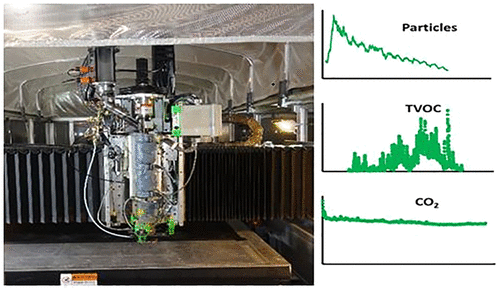当前位置:
X-MOL 学术
›
ACS Chem. Health Saf.
›
论文详情
Our official English website, www.x-mol.net, welcomes your
feedback! (Note: you will need to create a separate account there.)
Large-Format Additive Manufacturing and Machining Using High-Melt-Temperature Polymers. Part I: Real-Time Particulate and Gas-Phase Emissions
ACS Chemical Health & Safety ( IF 2.9 ) Pub Date : 2021-03-25 , DOI: 10.1021/acs.chas.0c00128 Aleksandr B Stefaniak 1 , Lauren N Bowers 1 , Stephen B Martin 1 , Duane R Hammond 2 , Jason E Ham 1 , J R Wells 1 , Alyson R Fortner 1 , Alycia K Knepp 1 , Sonette du Preez 3 , Jack R Pretty 2 , Jennifer L Roberts 2 , Johan L du Plessis 3 , Austin Schmidt 4 , Matthew G Duling 1 , Andrew Bader 4 , M Abbas Virji 1
ACS Chemical Health & Safety ( IF 2.9 ) Pub Date : 2021-03-25 , DOI: 10.1021/acs.chas.0c00128 Aleksandr B Stefaniak 1 , Lauren N Bowers 1 , Stephen B Martin 1 , Duane R Hammond 2 , Jason E Ham 1 , J R Wells 1 , Alyson R Fortner 1 , Alycia K Knepp 1 , Sonette du Preez 3 , Jack R Pretty 2 , Jennifer L Roberts 2 , Johan L du Plessis 3 , Austin Schmidt 4 , Matthew G Duling 1 , Andrew Bader 4 , M Abbas Virji 1
Affiliation

|
The literature on emissions during material extrusion additive manufacturing with 3-D printers is expanding; however, there is a paucity of data for large-format additive manufacturing (LFAM) machines that can extrude high-melt-temperature polymers. Emissions from two LFAM machines were monitored during extrusion of six polymers: acrylonitrile butadiene styrene (ABS), polycarbonate (PC), high-melt-temperature polysulfone (PSU), poly(ether sulfone) (PESU), polyphenylene sulfide (PPS), and Ultem (poly(ether imide)). Particle number, total volatile organic compound (TVOC), carbon monoxide (CO), and carbon dioxide (CO2) concentrations were monitored in real-time. Particle emission rate values (no./min) were as follows: ABS (1.7 × 1011 to 7.7 × 1013), PC (5.2 × 1011 to 3.6 × 1013), Ultem (5.7 × 1012 to 3.1 × 1013), PPS (4.6 × 1011 to 6.2 × 1012), PSU (1.5 × 1012 to 3.4 × 1013), and PESU (2.0 to 5.0 × 1013). For print jobs where the mass of extruded polymer was known, particle yield values (g–1 extruded) were as follows: ABS (4.5 × 108 to 2.9 × 1011), PC (1.0 × 109 to 1.7 × 1011), PSU (5.1 × 109 to 1.2 × 1011), and PESU (0.8 × 1011 to 1.7 × 1011). TVOC emission yields ranged from 0.005 mg/g extruded (PESU) to 0.7 mg/g extruded (ABS). The use of wall-mounted exhaust ventilation fans was insufficient to completely remove airborne particulate and TVOC from the print room. Real-time CO monitoring was not a useful marker of particulate and TVOC emission profiles for Ultem, PPS, or PSU. Average CO2 and particle concentrations were moderately correlated (rs = 0.76) for PC polymer. Extrusion of ABS, PC, and four high-melt-temperature polymers by LFAM machines released particulate and TVOC at levels that could warrant consideration of engineering controls. LFAM particle emission yields for some polymers were similar to those of common desktop-scale 3-D printers.
中文翻译:

使用高熔点聚合物的大型增材制造和加工。第一部分:实时颗粒物和气相排放
有关 3D 打印机材料挤出增材制造过程中排放的文献不断增多;然而,有关可挤出高熔体温度聚合物的大幅面增材制造 (LFAM) 机器的数据却很少。在挤出六种聚合物期间,对两台 LFAM 机器的排放进行了监测:丙烯腈丁二烯苯乙烯 (ABS)、聚碳酸酯 (PC)、高熔点聚砜 (PSU)、聚醚砜 (PESU)、聚苯硫醚 (PPS)、和 Ultem(聚醚酰亚胺)。实时监测颗粒物数量、总挥发性有机化合物(TVOC)、一氧化碳(CO)和二氧化碳(CO 2 )浓度。颗粒排放率值(个/分钟)如下:ABS(1.7 × 10 11至 7.7 × 10 13 )、PC(5.2 × 10 11至 3.6 × 10 13 )、Ultem(5.7 × 10 12至 3.1 × 10 13 )、PPS(4.6 × 10 11至 6.2 × 10 12 )、PSU(1.5 × 10 12至 3.4 × 10 13 )和 PESU(2.0 至 5.0 × 10 13 )。对于已知挤出聚合物质量的打印作业,颗粒屈服值(g –1挤出)如下:ABS(4.5 × 10 8至 2.9 × 10 11 )、PC(1.0 × 10 9至 1.7 × 10 11 ) 、PSU(5.1 × 10 9至 1.2 × 10 11 )和 PESU(0.8 × 10 11至 1.7 × 10 11 )。 TVOC 排放量范围为 0.005 mg/g 挤出物 (PESU) 至 0.7 mg/g 挤出物 (ABS)。使用壁挂式排气扇不足以完全清除打印室中的空气中的颗粒物和总挥发性有机化合物 (TVOC)。 实时 CO 监测并不是 Ultem、PPS 或 PSU 颗粒物和 TVOC 排放概况的有用标记。 PC 聚合物的平均 CO 2和颗粒浓度呈中等相关性 ( r s = 0.76)。使用 LFAM 机器挤出 ABS、PC 和四种高熔点聚合物时会释放出颗粒物和 TVOC,其水平可能需要考虑工程控制。某些聚合物的 LFAM 粒子发射率与常见桌面级 3D 打印机的粒子发射率相似。
更新日期:2021-05-24
中文翻译:

使用高熔点聚合物的大型增材制造和加工。第一部分:实时颗粒物和气相排放
有关 3D 打印机材料挤出增材制造过程中排放的文献不断增多;然而,有关可挤出高熔体温度聚合物的大幅面增材制造 (LFAM) 机器的数据却很少。在挤出六种聚合物期间,对两台 LFAM 机器的排放进行了监测:丙烯腈丁二烯苯乙烯 (ABS)、聚碳酸酯 (PC)、高熔点聚砜 (PSU)、聚醚砜 (PESU)、聚苯硫醚 (PPS)、和 Ultem(聚醚酰亚胺)。实时监测颗粒物数量、总挥发性有机化合物(TVOC)、一氧化碳(CO)和二氧化碳(CO 2 )浓度。颗粒排放率值(个/分钟)如下:ABS(1.7 × 10 11至 7.7 × 10 13 )、PC(5.2 × 10 11至 3.6 × 10 13 )、Ultem(5.7 × 10 12至 3.1 × 10 13 )、PPS(4.6 × 10 11至 6.2 × 10 12 )、PSU(1.5 × 10 12至 3.4 × 10 13 )和 PESU(2.0 至 5.0 × 10 13 )。对于已知挤出聚合物质量的打印作业,颗粒屈服值(g –1挤出)如下:ABS(4.5 × 10 8至 2.9 × 10 11 )、PC(1.0 × 10 9至 1.7 × 10 11 ) 、PSU(5.1 × 10 9至 1.2 × 10 11 )和 PESU(0.8 × 10 11至 1.7 × 10 11 )。 TVOC 排放量范围为 0.005 mg/g 挤出物 (PESU) 至 0.7 mg/g 挤出物 (ABS)。使用壁挂式排气扇不足以完全清除打印室中的空气中的颗粒物和总挥发性有机化合物 (TVOC)。 实时 CO 监测并不是 Ultem、PPS 或 PSU 颗粒物和 TVOC 排放概况的有用标记。 PC 聚合物的平均 CO 2和颗粒浓度呈中等相关性 ( r s = 0.76)。使用 LFAM 机器挤出 ABS、PC 和四种高熔点聚合物时会释放出颗粒物和 TVOC,其水平可能需要考虑工程控制。某些聚合物的 LFAM 粒子发射率与常见桌面级 3D 打印机的粒子发射率相似。











































 京公网安备 11010802027423号
京公网安备 11010802027423号